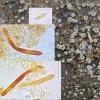
01-05-2017 16:51
 Blasco Rafael
Blasco Rafael
Hola, he recogido lo que creo es Trichopezizella n

01-05-2017 12:59
Steve ClementsBonjour,Nous avons trouvé cet Asco sur un bâton.

01-05-2017 12:08
 Tanja Böhning
Tanja Böhning
Bonjour, Nous avons une Morchella dans une sabli�

30-04-2017 16:08
Jan KnuimanHello, We found these very small cups (diameter c

30-04-2017 17:48
 Andgelo Mombert
Andgelo Mombert
Bonsoir à tous,Récolte sur Picea ou Abies, à la

28-04-2017 20:14
Till LohmeyerHi, ascofriendsdoes anybody have access to the fol

19-04-2017 15:26
Gernot FriebesHi again,here is another fungus that puzzles me a

23-04-2017 21:26
 Bernard CLESSE
Bernard CLESSE
Bonsoir à tous,Voici ce que je pense être Cistel
Petit asco poilu
Andgelo Mombert,
01-05-2017 16:41
 Bonsoir à tous,
Bonsoir à tous,De minuscules apothécies (1,5 mm) sur bois mort imbu de conifère.
Spores fusiformes, 13 x 3 µm, septés à maturité, à deux grosses guttules centrales et des autres plus petites autour.
Asques 80 x 6 µm, pleurorynques, octosporées, IKI + au sommet.
Poils 70 x 3 µm septés, granuleux, de couleur brun clair et plus pâles dans le dernier article.
Merci pour votre aide.
Andgelo
Andgelo Mombert,
01-05-2017 16:53

Re : Petit asco poilu
Dans les Lasiobelonium peut-être ?
Hans-Otto Baral,
01-05-2017 17:19

Re : Petit asco poilu
Yes, probably L. lonicerae.
Andgelo Mombert,
01-05-2017 17:48

Re : Petit asco poilu
Merci pour cette réponse.
J'éliminerais L. corticale qui possède des spores plus grandes et sans cloisons et L. variegatum aux spores finement guttulées au extrémités et qui possède des paraphyses lancéolées.
L. lonicerae semble coller, existe-t-il d'autres espèces dans ce genre ?
Andgelo
J'éliminerais L. corticale qui possède des spores plus grandes et sans cloisons et L. variegatum aux spores finement guttulées au extrémités et qui possède des paraphyses lancéolées.
L. lonicerae semble coller, existe-t-il d'autres espèces dans ce genre ?
Andgelo
Hans-Otto Baral,
01-05-2017 18:29

Re : Petit asco poilu
Yes, but the genus is not easy. You should have your photos in living state, figure the paraphyses, the ascus base, and a series of free living spores.
Coniferous substrate is a bit strange, but L. lonicerae is plurivorous.
Coniferous substrate is a bit strange, but L. lonicerae is plurivorous.
Andgelo Mombert,
01-05-2017 18:47

Re : Petit asco poilu
D'accord. Merci pour cette réponse !
Andgelo
Andgelo
